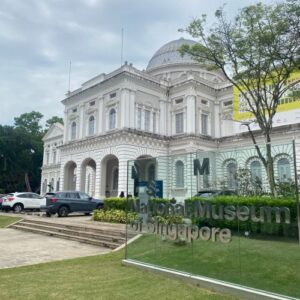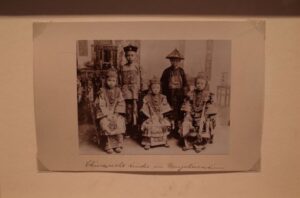ヒマーラヤ高地における景観の人類学的研究
対象とする問題の概要 地球規模の環境問題が科学的かつ政治的に議論を呼ぶ事実となるなか、ヒマーラヤ高地は周極地域とならんで、気候変動の影響がとりわけ深刻に現れる場所であることがしばしば指摘される。しかし、この「新たなヒマーラヤの危機」をめぐ…

The photo of National Museum of Singapore
When examining the economic situations of Malaysia and Singapore, it can be observed that both countries are characterized by government-linked companies (GLCs). These companies are closely intertwined with the economic policies and strategies of their respective governments, playing a crucial role in supporting national economic development. However, despite being multiethnic nations, the circumstances of the Chinese community in these two countries are markedly disparate. The Chinese community in Malaysia holds significant prominence, constituting a substantial portion of the population. Malaysia is a multicultural country with Malays, Chinese, Indians, and other ethnic groups. However, Malaysia has implemented policies aimed at promoting Malay dominance in government and the economy. This has resulted in what is often termed “Bumiputera affirmative action” which affect the development opportunities of the Chinese community.
On the other hand, The Chinese community in Singapore is the majority and holds a dominant position in the country. Singapore emphasizes racial harmony and has taken measures to ensure equal rights for all ethnic communities. Singapore’s policies focus on racial integration and equality. This means that the Chinese community in Singapore does not face similar restrictions in government and the economy.
While both Malaysia and Singapore have Chinese communities, their status and circumstances in the two countries are significantly different. These differences stem primarily from the policies of their governments and their approaches to multiculturalism. These distinctions are also reflected in the social and economic structures of the two nations, and are essential for understanding the cultures and histories of both. Before I conduct research about the differences in political and economic policies in both nations, I would like to learn more details about their history to know how their policies and communities shaped.
This research aimed to:
1. Investigating the historical, political, and socio-cultural factors that have contributed in shaping these differences in policies and governance between Singapore and Malaysia. Especially focus on the aspect of Chinese community.
2. Understanding Malaysia’s “Malayization” Policy which aimed to promote Malay dominance in various aspects of the nation.

Chinese children in New Year’s dress Took in the Peranakan museum
I conducted my field work for 15days in Kuala Lumpur, Penang of Malaysia and Singapore. In Kuala Lumpur, I visited Jeffrey Cheah Institute for Southeast Asia in Sunway university, discussed about my research plan with several professors. When I went to Penang, I interviewed 3 taxi drivers who are Chinese but living in Malaysia for a long time. They told me about their own family histories, and described the situation and experiences for being a Chinese people in Malaysia since they were born.
In Singapore, I visited several museums to learn the history in Singapore and Malaysia. In the Peranakan museum, which showcases the distinctive art and culture of various Peranakan communities across Southeast Asia. In Singapore today, the term “Perankan” generally refers to a person of mixed Chinese and Malay/Indonesian heritage. There are hundreds of photographs of past and present day Peranakans, contributed by the communities, illustrating the diversity and richness of Peranakan cultural heritage. The gallery there also features video interviews where respondents share their thoughts and reflections on what “Peranakan” means to them.
I also went to the national museum in Singapore which is close to Peranakan museum. This is the nation’s oldest museum that seeks to inspire with stories of Singapore and the Southeast Asia. Its galleries adopt multi-perspective ways of presenting history and culture featuring important artefacts. The rich collection of the National Museum of Singapore showcases the history and civilization from the 14th century to this day.
Through this experience, I have gained a profound understanding of the history and traditional culture of Singapore and Malaysia. Additionally, I have developed insights into the Chinese communities in both countries.
As I wrote in my research tittle, to compare economic policies and the impact of GLCs between Singapore and Malaysia is the next objective. Before that, I should learn more of the history, economy, politics and other aspects of both countries. As I attempt to investigate the multifaceted influence of GLCs policy on Chinese-owned enterprises or Chinese community in Malaysia, I will read more previous research and learn the methodology required for.
Copyright © 附属次世代型アジア・アフリカ教育研究センター All Rights Reserved.